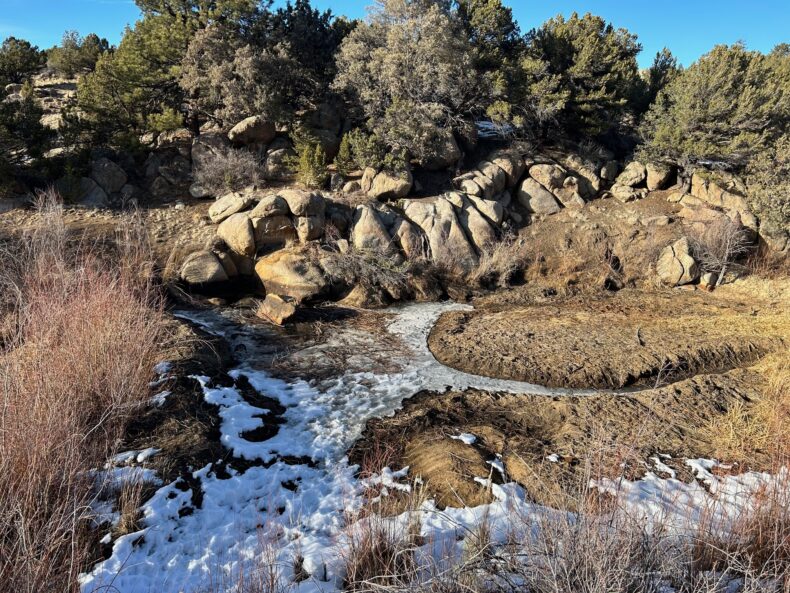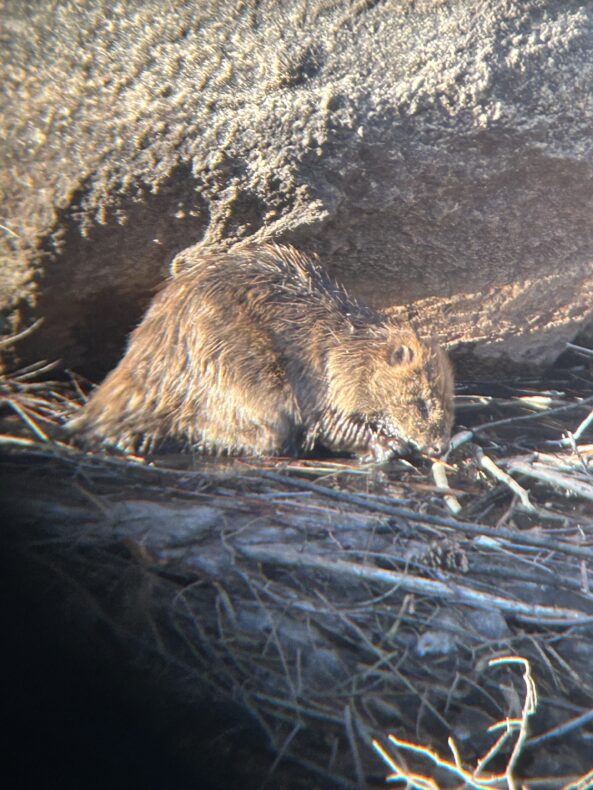
Years ago, Carol Evans, then a Bureau of Land Management biologist in northeastern Nevada, told me she wanted to write a book called Stream Stories — a series of vignettes about the many creeks that webbed her region and defined her career. I have no idea if she’s working on this today (Carol, if you’re reading this, I hope you are!), but it always struck me as a brilliant premise. Streams and narratives have much in common: they flow between points yet never truly end, they are subject to the forces of history yet shape it themselves. And they both have protagonists — in the streams’ case, the living beings who dwell within them and, in some cases, sculpt their physical form.
Here, then, is my stab at a brief stream story, featuring a waterway called Sevenmile Creek. And, like so many good stream stories, it co-stars beavers.
Sevenmile Creek runs down a shoulder of scraggly pinyon-juniper forest that looms above Buena Vista, Colorado, a town on the banks of the Arkansas River. For the last several years, Sevenmile’s flow has been diminishing, for reasons that aren’t entirely clear — drought, perhaps, or some subtle change in hydrology or land use. Regardless, the dwindling water has spelled trouble for its resident beavers, which, though capable of transforming even the thinnest streams into robust ponds, can’t conjure water from thin air.
One January morning, I paid Sevenmile’s beavers a visit with Mark Beardsley, Cat Beardsley, and Jessica Doran, three beaver aficionados who restore Colorado streams under the banner of a company called EcoMetrics. We walked a couple of miles down one of the gazillion rutted dirt roads that cuts across public land in this corner of Colorado, our dogs weaving around our ankles. Distant coyotes yipped and wailed.
When the road reached Sevenmile Creek, we found it had gone virtually dry. A stranded beaver lodge, its normally submerged entrances yawning like cave mouths, stood in a damp meadow, the crumbling ruins of an ancient kingdom. I felt a twinge of foreboding.
A little higher up, a colony of beavers was still hanging on, but barely. Behind the long berm of their dam, a frozen pond, no larger than a pickleball court, was tucked against a sheer rock face. Stains high on the granite wall revealed where the fast-disappearing water had stood months earlier. The shrinking, iced-over pond was nearly solid, locking into place the beavers’ food cache, the bundle of willow stems they’d spent the autumn assembling into place. Only one narrow aperture of open water, roughly the diameter of a five-gallon bucket, lapped against the rock: the colony’s single point of egress from its now-frozen stronghold.
Beavers, of course, are well-adapted to winter; ordinarily they spend the chilly months feeding and frolicking beneath an ice roof as happily as Arctic seals. But this situation seemed abnormal, and perilous. Their stream had all but dried up, their food stores had frozen solid, and their pond was vanishing almost in real time. The beavers always had the option of leaving, that was true. But, since the stream only held sporadic pockets of water, that would mean waddling long stretches overland — not a semiaquatic mammal’s preferred mode of travel. And there were those howling coyotes to worry about.
“I thought they’d high-tail it out of here when it got really bad,” Mark said as we surveyed the scene from atop a bluff. “But once they settle in, they’re like, no, this is home, man.”
“It’s so grim. Do you guys wake up in the middle of the night worried about ‘em?” Jess said.
“A little bit,” Mark acknowledged.
A week earlier, Mark and Cat had visited the colony and delivered a bundle of carrots, a food that captive beavers generally adore. But the veggies still sat untouched on the ice. (Maybe an encouraging sign that the critters weren’t actively starving?) They’d also spotted an adult beaver popping from the airhole to feed on what little willow wasn’t sealed into the ice. “He would stick his head out, grab one of those branches, and tug it under,” Cat said.
Today the beaver was nowhere to be seen, though we heard the occasional hollow clunk of a portly rodent body moving around beneath the ice, and saw disturbed water rippling in the breathing hole. When we held our breath and the wind quieted, we could also hear the distant squealing and moaning of the kits, the babies, rising from some hidden burrow. It was hard not to interpret their calls as cries for help.

***
What, if any, is the moral of this particular stream story? It’s hard not to see it as an Anthropocene parable: the climate is changing, once-reliable resources are becoming ephemeral, our wild brethren are suffering, etc. And writ large, all of that is certainly true.
But I’m also not certain that this evergreen lesson applies to Sevenmile Creek. Beaver literature is rife with analogous stories, in which smart observers become convinced that winter will spell doom for a favorite colony. The Colorado naturalist Enos Mills, in his 1913 masterpiece In Beaver World, described monitoring a beaver lodge whose sole occupant had been sealed in by ice during a cold snap. When Mills and a friend broke through the lodge’s walls and crawled inside, they found the beaver was successfully weathering the harsh conditions. “(H)e had subsisted on the wood and the bark of some green sticks which had been built into an addition of the house during the autumn,” Mills reported. Nevertheless, Mills, convinced the beaver looked “emaciated,” brought him regular deliveries of aspen for the next six weeks; eventually the pond thawed, and “again the old fellow emerged into the water.”
Mills seemed to believe he’d saved the beaver’s life, and maybe he had; surely the critter appreciated the gifts. To me, though, it sounds like the beaver had fared just fine through his own innate intelligence and resourcefulness.
Or consider the author Hope Ryden, whose 1989 book Lily Pond did so much to endear beavers to the public. One fall, Ryden began to fret that her local colony, in which she’d invested so much time and love, hadn’t adequately prepared for the winter. “I had to conclude that their winter food larder left much to be desired,” she wrote, surveying their pitiful bushel of blueberry and mountain laurel. “Would they survive on such stuff? Why hadn’t they moved?” Like Mills before her, she delivered them aspen branches, doubtful they’d survive without help. “We’ve brought you Christmas dinner,” she told them upon dropping off one load.
Come spring, though, Ryden realized she needn’t have bothered:
“(I) made a surprising discovery. The shoreline was littered with hundreds of blackened lily rhizomes, refuse that had washed up after ice-out. And each one of these had been partially eaten. So that was how the beavers had made it through winter! I examined dozens of the long fibrous roots, broke them apart and looked at their insides. They had the consistency of raw potatoes. Clearly, the beavers had dug these swamp roots from the bottom muck and been sustained by them throughout their long imprisonment. So our donation of aspen branches had not been necessary after all!”
The urge to worry about beavers, and even to intervene on their behalf, is obviously a common one, and perfectly understandable — we feed birds in winter, why not beavers? And many surely do die every winter, of starvation or predation or exposure; it’s obviously a perilous season for any creature. Yet Castor canadensis is also a flexible, clever species; beavers possess survival strategies and techniques, honed over millions of years of evolution, that we may fail to comprehend or credit. As the beaver-watcher Bob Arnebeck put it in one blog post about Lily Pond: “I always assume that beavers know their business better than I.”
So where does that leave the Sevenmile Creek stream story? Like sagas and streams, it rolls on. The Sevenmile beavers may well be in dire trouble, as they appear to be; when we visit them later this winter, we might find them gone, or dead. Bringing them carrots and cottonwood branches is, in my view, entirely justifiable and compassionate, given all the ways in which we’ve made their lives harder over the last several centuries; as Jess put it to me later, “Why not help a neighbor out?” But it’s also conceivable that they’ll find a way even without us, as they’re wont to do, drawing upon secret reserves of guile and creativity and preparedness. This particular stream story may yet have a happy ending.
They have, after all, endured this long. “I figured they’d either move out or croak,” Mark said as we meandered back down the road and left the beavers to their own devices. “Well, they’re still kicking.”
Photos: the Sevenmile beaver pond and one of its occupants, courtesy of Mark Beardsley.
Ben, I’m half way through Crossings-been jumping around through the chapters. I am gobsmacked at the amount of research you have done (in archives and with people). Plus, the prose is beautiful. Although the subject matter is academic and the approach is analytical, the tone is conversational. I keep reading to hear what you have to say AND to hear how you say it.
All drivers would benefit from reading Crossings. The intro and parts of the epilogue should be required to renew a drivers license. Won’t happen but maybe more LWON people will indulge. Looking forward to Eager.
Thanks Tom! I’m thrilled to hear you’re enjoying CROSSINGS, and grateful for your generous words. And I like the idea of making it mandatory for drivers; lemme talk to our local DMV…
Thanks Ben, for all your work and words that convey what many have missed and help fill those voids that humans have often created without a thought…